It is fun watching birds with others.
It is fun watching birds with others, even though birding usually requires us to be quiet to avoid disturbing the birds, so they won’t fly off.
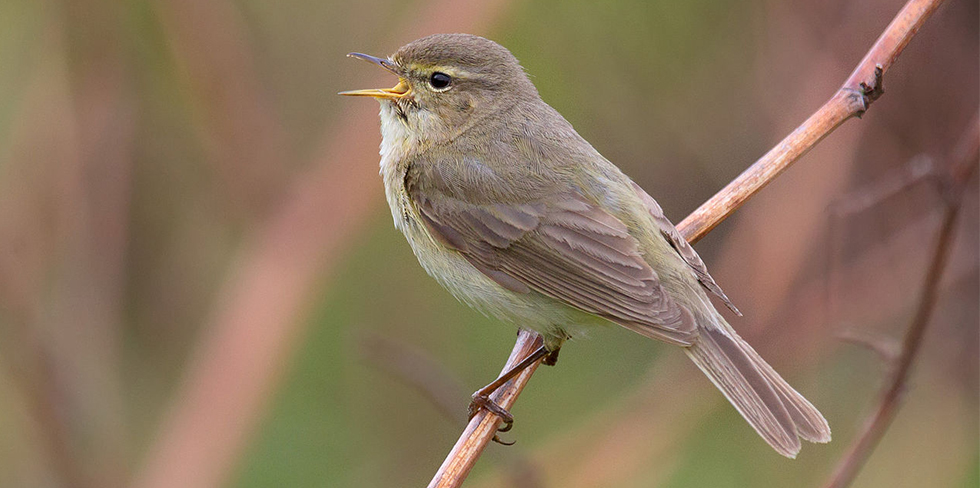
Urban birds, however, are accustomed to some noise. Nature conservation organizations usually offer programs or clubs for children and youth, and offer options for organized activities in addition to bird watching, such as saving frogs, environmental education and conservation, and work days to maintain natural areas. It is always worth it to look for a local group and to encourage kids to discover nature with others in their age group.
Bird identification and sketch books
If you cannot find a local group, how do you go about encouraging your kids to learn to identify birds? First of all, a bird identification book is important. There are lots of great apps, as well, but sometimes in nature it can be more relaxing to leave the smartphone in your pocket. Furthermore, WiFi and cellular data aren’t reliably available in some natural areas. The classic book in Europe, Birds of Europe with North Africa and the Middle East, was illustrated by Lars Jonsson, but there are similar books for most parts of the world. Drawing a bird—perhaps copying an image in a book—is a good method to study birds more closely. Even if your drawings do not look like those of Lars Jonsson, it is fun, and in the process, you might learn the details of the birds by noting their colors, shapes, and various feathers.
Encourage children to draw or color or paint birds they are already familiar with, especially birds they see in their yards or neighborhoods.
First identification via bird types
When you—or your kids—find a bird that you’d like to identify, first of all, notice the details. Keep your book or app closed for now: Birds fly away, but the reference material won’t leave your hands. Notice—even say aloud—many details of the bird: “That bill is almost as long as its head, and it curves down! See how short the tail is? Note that, when perched, the wing tips extend to the full length of the tail. Look at those yellow feet! I’d say that bird has a broken eye-ring. This bird has an equal sign on its wing—parallel wing bars. I’d say this bird is slightly smaller than a robin. That bird’s tail is notched!” New birders often notice color first, but more important are size, bill length and shape, leg length, and behavior. Of course, color is important, but rarely is color a distinguishing feature.
When you’ve spent a good, long time noting as many details as you can while watching the bird, or when it flies away or hides in the vegetation, it’s time to look it up in your reference guides.
FEW GUIDES ARE ARRANGED BY COLOR; MOST ARE ARRANGED BY GROUP—THE FAMILY OR TYPE OF BIRDS.
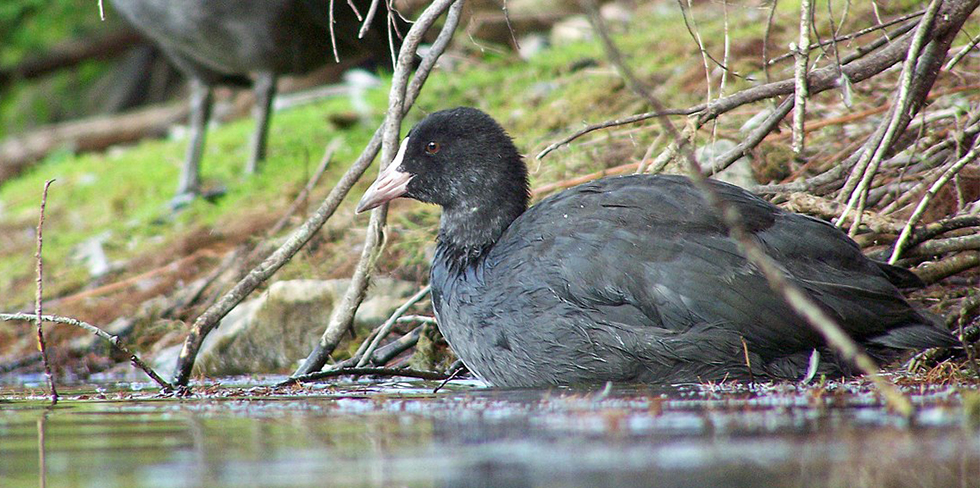
Black Coot 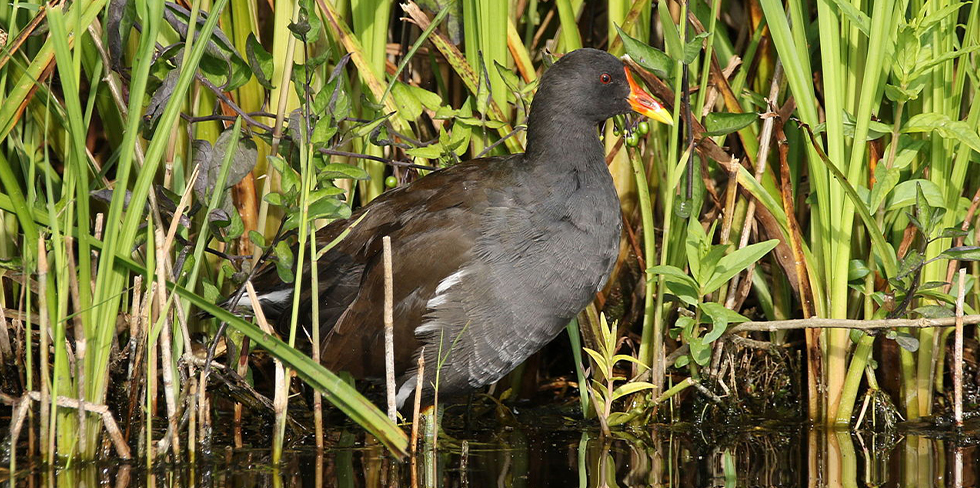
Common Moorhen
First, consider the bird’s habitat. That will help you narrow your options to the correct category of birds. For example, waterfowl—swans, geese, and ducks—are on adjacent pages of most field guides.
A duck on a lake is easy, though; you just look up ducks. But not all birds on lakes are waterfowl! Some birds on lakes resemble chickens—whose proper habitat is a farm! It’s true: Domestic chickens and ducks, the kind that produce eggs for breakfast, are most commonly found on farms. But on lakes, you might find chicken-lime birds, for example, the Black Coot, smaller than most ducks, and black with a white forehead. Coots are commonly found on lakes in Europe.
Even more exciting species can be found at water’s edge at the base of the reeds. This is where moorhens hide. With their shadowy coloration they are well camouflaged. To spot them usually requires an investigative sense, patience, and good binoculars.
Other bird families or types can also be defined by habitat or behavior. At the seaside you can expect gulls and terns as well as shorebirds and waders. Raptors are commonly spotted gliding in the air over open fields and meadows. The singing birds that perch in trees and bushes are not only at home in the woods but also in cities and gardens. Look for woodpeckers on tree trunks.
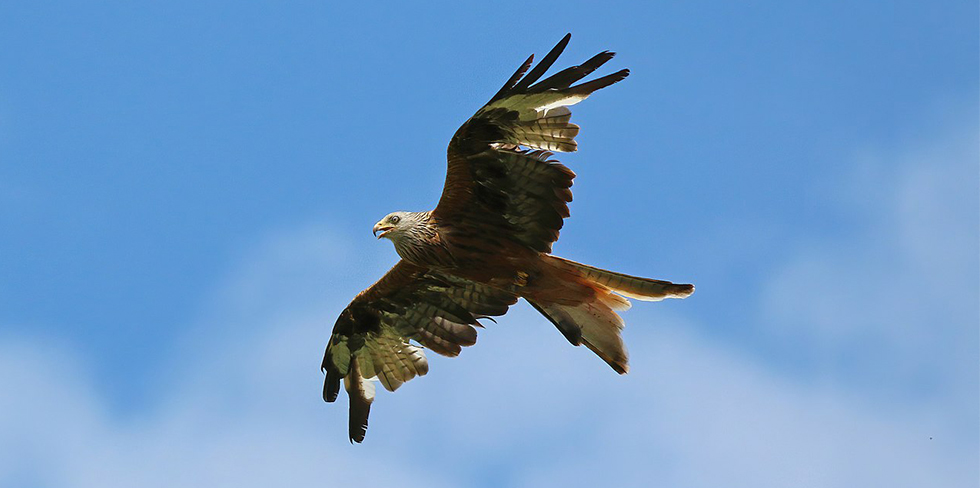
Match details to images
If you can figure out the bird group that includes the bird you found, it’s time to find that group in your field guide or app. Now it is about all the colors and the form. Among raptors, identify the red kite by its tail, which is forked. As you view it from below, note also its beautiful rust brown belly and the black and white wing pattern. You are likely to hear the common buzzard before you see it, as its call carries from far away. It may sound like your little sister when she wants something urgently. Its piiah rings like someone complaining, loud and demanding. The Common Kestrel, a small raptor, is often seen hovering in the air, shaking with wings to stay in one place in the air, hunting for frogs, insects, or rodents, then swooping down for its meal. Songbirds can often be observed from closer distances, and plumage color can be helpful in determining the species.
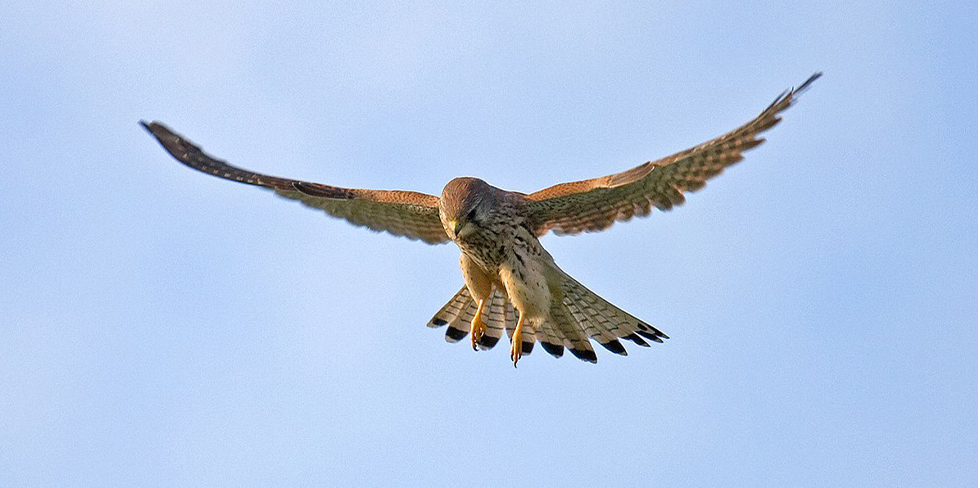
Common Kestrel 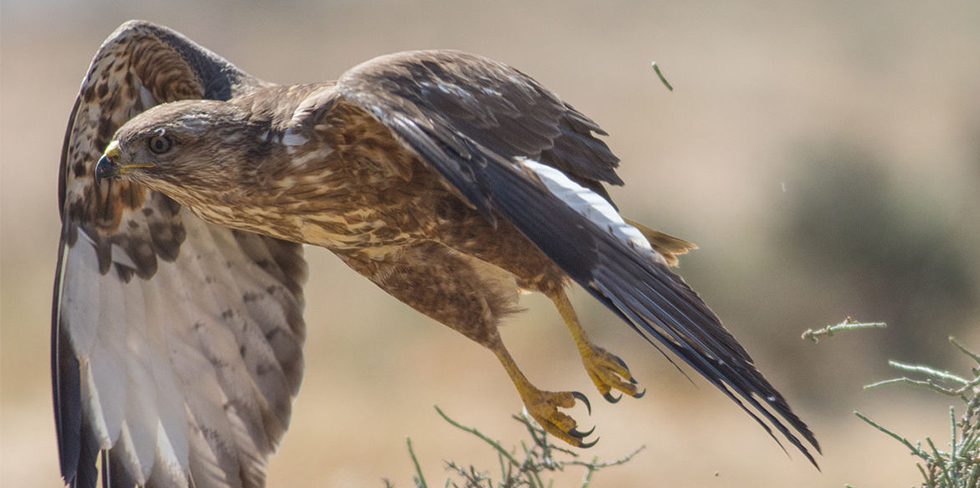
Common Buzzard
Make friends with the birds
The more you consider, categorize, and remember a bird’s habitat, flight style, behavior, and song, the more likely you are to remember and recognize it again. This is not different than with people. You probably recognize your best friend from five meters distance: how he or she walks. You can probably recognize your child’s voice even among a crowd of children. Perhaps, the Common Chiffchaff, which is rather unobtrusive, will soon become your friend, a friend you recognize by the sound of its voice. We wish you lots of fun with your new friends!